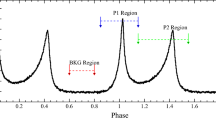Abstract
Asteroseismology relies on accurate mode identification.High-resolution spectroscopy allows to detect such crucial informationas the pulsational degree ℓ, the azimuthal number m, andpulsation amplitudes, directly from time series of observations. Theadvantage of high-resolution spectroscopy over standard photometrictechniques is that not only pulsational temperature variations can bedetected, but also the pulsational velocity field, yielding valuableextra information.In this paper I review the mode-identification methods that havebeen developed over the last decades, with emphasis on theapplication to hot main-sequence stars.
Similar content being viewed by others
References
Aerts, C.: 1996, A&A 314, 115.
Aerts, C., Mathias, P., Gillet, D. and Waelkens, C.: 1994, A&A 286, 109.
Aerts, C. and Waelkens, C.: 1993, A&A 273, 135.
Aerts, C. and Eyer, L.: 2000, A.S.P. Conf. Ser. 210, 113.
Aerts, C. and Kaye, A.B.: 2001, ApJ 553, 814.
Balona, L.A.: 1986, MNRAS 219, 111.
Balona, L.A.: 2000a, A.S.P. Conf. Ser. 210, 170.
Balona, L.A.: 2000b, MNRAS 318, 289.
Balona, L.A.: 2000c, MNRAS 319, 606.
Balona, L.A. et al.: 2001a, MNRAS 324, 1041.
Balona, L.A., Bartlett, B. and Caldwell, J.A.R.: 2001b, MNRAS 321, 239.
Bedding, T.R., Butler, R.P. and Kjeldsen, H.: 2001, ApJ 549, L105.
Berdyugina, S. et al.:2000, A.S.P. Conf. Ser. 214, 268.
Bouchy, F. and Carrier, F.: 2001, A&A 374, L5.
Buta, R.J. and Smith, M.A.: 1979, ApJ 232, 213.
Carrier, F., Bouchy, F., Kienzle, F. et al.: 2001, A&A 378, 142.
Chadid, M., De Ridder, J., Aerts, C. and Mathias, P.: 2001, A&A 375, 113.
Cugier, H. and Daszynska, J.: 2001, A&A 377, 113.
Gies, D.R. and Kullavanijaya, A.: 1988, ApJ 326, 813.
Hao, J.: 1998, ApJ 500, 440.
Hao, J.: 2000, Ap&SS 271, 145.
Hatzes, A.P. and Cochran, W.D.: 2000, AJ 120, 979.
Jankov, S., Janot-Pacheco, E. and Leister, N.V.: 2000, ApJ 540, 535.
Jankov, S. et al.: 2001, A&A 377, 721.
Kennelly, E.J., Walker, G.A.H. and Merryfield, W.J.: 1992, ApJ 400, L71.
Kennelly, E.J., Brown, T.M., Kotak, R. et al.: 1998, ApJ 495, 440.
Kochukhov, O. and Ryabchikova, T.: 2001, A&A 374, 615.
Koen, C., Balona, L., van Wyk, F. et al.: 2002, MNRAS 330, 567.
Ledoux, P.: 1951, ApJ 114, 373.
Lee, U. and Saio, H.: 1990, ApJ 349, 570.
Lee, U., Jeffery, C.S. and Saio, H.: 1992, MNRAS 254, 185.
Mantegazza, L.: 2000, A.S.P. Conf. Ser. 210, 138.
Mantegazza, L., Zerbi, F.M. and Sacchi, A.: 2000, A&A 354, 112.
Mantegazza, L., Poretti, E. and Zerbi, F.M.: 2001, A&A 366, 547.
Mathias, P., Aerts, C., Briquet, M. et al.: 2001, A&A 379, 905.
Montgomery, M.H.: 2002, A.S.P. Conf. Ser. 259, 216.
Neiner, C., Hubert, A.-M., Floquet, M. et al.: 2002, A&A 388, 899.
O'Toole, S.J., Bedding, T.R. and Kjeldsen, H.: 2000, ApJ 537, L53.
Osaki, Y.: 1971, PASJ 23, 485.
Rivinius, Th., Baade, D., Stefl, S. et al.: 2001, A&A 369, 1058.
Saio, H., Kambe, E. and Lee, U.: 2000, ApJ 543, 359.
Schrijvers, C. and Telting, J.H.: 2002, A&A (in press).
Smith, M.A.: 1977, ApJ 215, 574.
Telting, J.H. and Schrijvers, C.: 1997, A&A 317, 723.
Telting, J.H., Aerts, C. and Mathias, P.: 1997, A&A 322, 493.
Telting, J.H., Abbott, J.B. and Schrijvers, C.: 2001, A&A 377, 104.
Townsend, R.H.D.: 1997, MNRAS 284, 839.
Townsend, R.H.D.: 1999, MNRAS 310, 851.
Uytterhoeven, K., Aerts, C., De Cat, P. et al.: 2001, A&A 371, 1035.
Viskum, M., Kjeldsen, H. and Bedding, T.R.: 1998, A&A 335, 549.
Vogt, S.S. and Penrod, G.D.: 1983, ApJ 275, 661.
Woolf, V.M., Jeffery, C.S. and Pollacco, D.L.: 2002, MNRAS 329, 497.
Author information
Authors and Affiliations
Rights and permissions
About this article
Cite this article
Telting, J. High-Resolution Spectroscopy for Pulsation-Mode Identification. Astrophysics and Space Science 284, 85–96 (2003). https://doi.org/10.1023/A:1023236728853
Issue Date:
DOI: https://doi.org/10.1023/A:1023236728853




